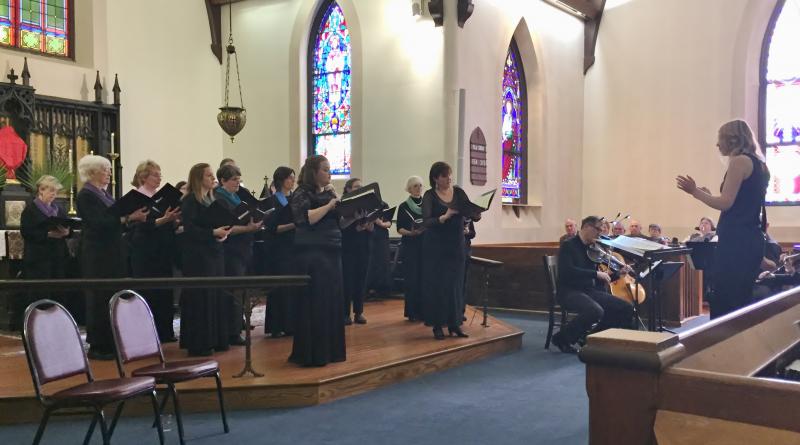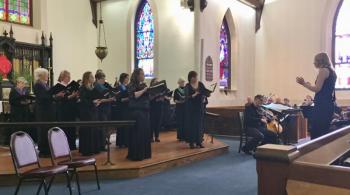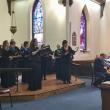Baroque beautiful voices at St. Paul’s
The Oratorio Chorale’s female chamber choir, The Sweetest in the Gale, performed a series of Baroque period masterworks on Sunday, April 9, at St. Paul’s in Brunswick.
The Baroque musical era, as well as the Baroque art period, were often denigrated as overly ornate. In art, Baroque is characterized by a great deal of motion, detail and drama. Every painting you’ve ever seen with tiny cherubim flying around a scene of great drama, such as the Crucifixion, wringing their hands or crying to heaven is a Baroque painting. Compare that sort of image to an earlier painting of the Madonna and Child sitting on a setting of rocks and smiling serenely, and you’ll see the difference instantly. The Baroque followed the Renaissance, which in art was all about order and balance and perspective. On the other hand, the Baroque music era preceded a similar era in music – the classical era, which was all about order and balance and timing, so even though the art and music Baroque periods began about the same time, the changes they created were quite different.
New musical forms arose in the Baroque from the polyphony of the Renaissance music period. Most notably, opera became a new musical form during the later part of the Baroque era, along with the magic of counterpoint, a type of polyphony that created its own perfect harmonies. Many, though not all, of the subjects of Baroque music, unlike Renaissance music, were sacred, and much of Baroque music was written for the church or for patrons who wanted their own musical offering for the church, such as their own Requiem mass. Much of Renaissance music was a capella, or without instrumentation, and few instruments – the lute, the recorder, and the clavichord – were prevalent. In the Baroque, much new instrumentation also came about – the basis of the string quartet, with the new addition of a deeper voice to provide basso continuo as well as many other stringed instruments, new woodwinds, brass instruments, and the introduction of the organ. Additionally, notation became more standardized, which made it possible to score pieces for multiple voices.
At the concert on Sunday, there were several a capella pieces, but also pieces in which the voices were backed up by organ and a string quartet.
The first piece was a capella, by Claudio Monteverdi, who straddled the Renaissance and Baroque periods. His early madrigals were very much products of the Renaissance, but Monteverdi also wrote with basso continuo, the Baroque voice that underlay much of the contrapuntal work. His opera, L’Orfeo, is the earliest surviving opera still regularly performed. The work performed, like many of Monteverdi’s work, was sacred – Angelus ad pastores ait, which tells the story of the angel who appeared to the shepherds on the night of Jesus’ birth. A second motet, Ubi Duo Vel Tres (Where Two or Three Are Gathered) was also performed a capella. The female polyphony in both cases builds throughout the pieces, to a bright counterpoint in the alleluia sections.
A third piece completed the early Baroque offerings, Duo Seraphim Clamabant, by Tomas Luis de Victoria.
The middle Baroque period offerings were both from female composers, which, although rare, was not unheard of in the Baroque. Barbara Strozzi of Venice composed around 1644, and her only sacred work that survives was written in 1655. It does not follow the regular church liturgy. In the piece sung by the Chorale, the relationship between singers and Christ is intimate and intense. Quis dabit mihi? asks “Who will bestow a burning love, causing my heart to languish, longing for Jesus? No one but Christ, who to me is love itself.” The music, as well as the lyrics, are typical of a love song, not the liturgical storytelling favored by the early Baroque. The singers, including soprano Mary Sullivan, who sang part of the music as a solo, nudged the lovely piece to just this side of erotic.
The other piece written during the middle period was another version of Duo Seraphim, written by Caterina Assandra, about whom little is known. She played the organ, was probably born in Pavia, and became a Benedictine nun the year Duo Seraphim was composed. She continued to compose, and the latest pieces were dated about 1618. Sweeter and more lyrical than the de Victoria Seraphim, it is more suited to the female voice – the de Victoria work was probably written for a boys’ choir – and the women of the Chorale did it great justice.
The final piece in the program was a late Baroque work by Giovanni Battista Pergolesi, who was writing toward the end of J.S. Bach’s lifetime. Bach’s death is typically considered to be the end of the Baroque period. Pergolesi’s Stabat Mater, a piece in 12 short movements, was written at the very end of his life while he was dying of tuberculosis. It was his best known sacred work in his short musical career. The text is drawn from a thirteenth century hymn describing the suffering of the Virgin at her son’s crucifixion. It was written for a duet of soprano and alto, but in its day, it was performed by whomever was available. Mary Sullivan, as well as alto soloist Jenna Guiggery, performed with the choir, and were supported musically by Ray Cornils on organ as well as a string quartet. The arias and duets performed by the soloists were interspersed with music sung by the chorus. The piece was highly operatic, which didn’t often match the lyrics. This was not uncommon during the Baroque, where a sprightly dance was paired with a solemn set of lyrics.
The program was conducted by Emily Isaacson, who began the women’s chorale in 2015 to be used in musical offerings similar to this. The next Oratorio Chorale concert, with the chorale, Sullivan, and countertenor Reginald Mobley, is called “Amazing Grace: The American Spiritual,” and will be performed in collaboration with the Portland Abyssinian Meeting House on Friday, May 19, and Saturday, May 20.
Event Date
Address
United States
























